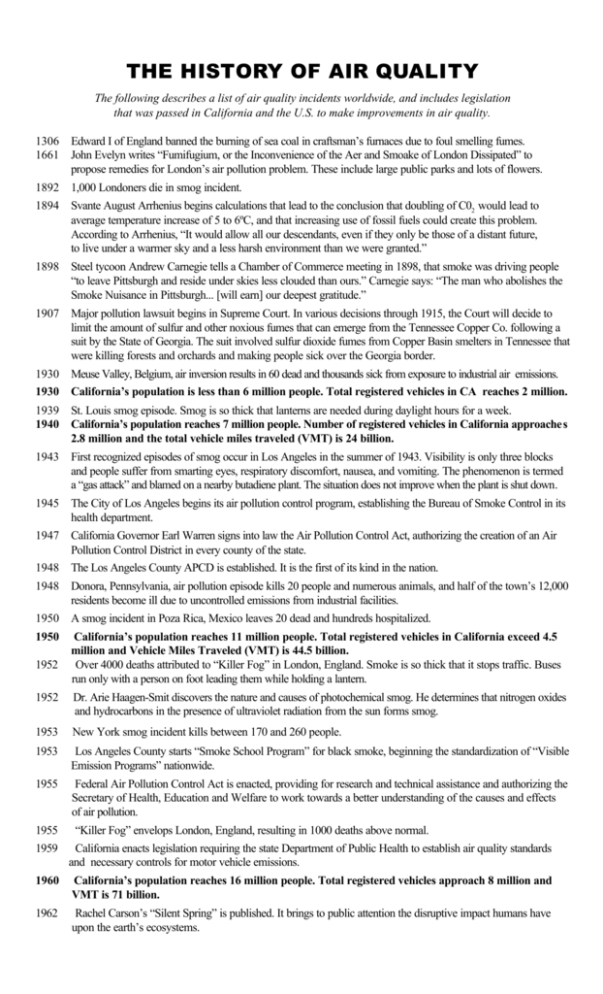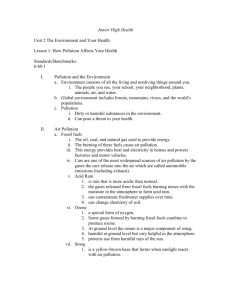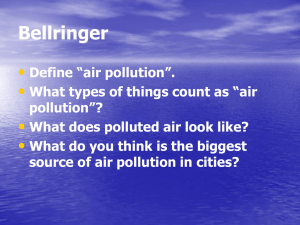the history of air quality - Yolo-Solano Air Quality Management District
advertisement

THE HISTORY OF AIR QUALITY The following describes a list of air quality incidents worldwide, and includes legislation that was passed in California and the U.S. to make improvements in air quality. 1306 1661 Edward I of England banned the burning of sea coal in craftsman’s furnaces due to foul smelling fumes. John Evelyn writes “Fumifugium, or the Inconvenience of the Aer and Smoake of London Dissipated” to propose remedies for London’s air pollution problem. These include large public parks and lots of flowers. 1892 1894 1,000 Londoners die in smog incident. Svante August Arrhenius begins calculations that lead to the conclusion that doubling of C02 would lead to average temperature increase of 5 to 6ºC, and that increasing use of fossil fuels could create this problem. According to Arrhenius, “It would allow all our descendants, even if they only be those of a distant future, to live under a warmer sky and a less harsh environment than we were granted.” 1898 Steel tycoon Andrew Carnegie tells a Chamber of Commerce meeting in 1898, that smoke was driving people “to leave Pittsburgh and reside under skies less clouded than ours.” Carnegie says: “The man who abolishes the Smoke Nuisance in Pittsburgh... [will earn] our deepest gratitude.” 1907 Major pollution lawsuit begins in Supreme Court. In various decisions through 1915, the Court will decide to limit the amount of sulfur and other noxious fumes that can emerge from the Tennessee Copper Co. following a suit by the State of Georgia. The suit involved sulfur dioxide fumes from Copper Basin smelters in Tennessee that were killing forests and orchards and making people sick over the Georgia border. 1930 1930 Meuse Valley, Belgium, air inversion results in 60 dead and thousands sick from exposure to industrial air emissions. California’s population is less than 6 million people. Total registered vehicles in CA reaches 2 million. 1939 1940 St. Louis smog episode. Smog is so thick that lanterns are needed during daylight hours for a week. California’s population reaches 7 million people. Number of registered vehicles in California approaches 2.8 million and the total vehicle miles traveled (VMT) is 24 billion. 1943 First recognized episodes of smog occur in Los Angeles in the summer of 1943. Visibility is only three blocks and people suffer from smarting eyes, respiratory discomfort, nausea, and vomiting. The phenomenon is termed a “gas attack” and blamed on a nearby butadiene plant. The situation does not improve when the plant is shut down. 1945 The City of Los Angeles begins its air pollution control program, establishing the Bureau of Smoke Control in its health department. California Governor Earl Warren signs into law the Air Pollution Control Act, authorizing the creation of an Air Pollution Control District in every county of the state. The Los Angeles County APCD is established. It is the first of its kind in the nation. 1947 1948 1948 1950 1950 1952 Donora, Pennsylvania, air pollution episode kills 20 people and numerous animals, and half of the town’s 12,000 residents become ill due to uncontrolled emissions from industrial facilities. A smog incident in Poza Rica, Mexico leaves 20 dead and hundreds hospitalized. California’s population reaches 11 million people. Total registered vehicles in California exceed 4.5 million and Vehicle Miles Traveled (VMT) is 44.5 billion. Over 4000 deaths attributed to “Killer Fog” in London, England. Smoke is so thick that it stops traffic. Buses run only with a person on foot leading them while holding a lantern. 1952 Dr. Arie Haagen-Smit discovers the nature and causes of photochemical smog. He determines that nitrogen oxides and hydrocarbons in the presence of ultraviolet radiation from the sun forms smog. 1953 New York smog incident kills between 170 and 260 people. 1953 Los Angeles County starts “Smoke School Program” for black smoke, beginning the standardization of “Visible Emission Programs” nationwide. 1955 Federal Air Pollution Control Act is enacted, providing for research and technical assistance and authorizing the Secretary of Health, Education and Welfare to work towards a better understanding of the causes and effects of air pollution. 1955 1959 “Killer Fog” envelops London, England, resulting in 1000 deaths above normal. California enacts legislation requiring the state Department of Public Health to establish air quality standards and necessary controls for motor vehicle emissions. 1960 California’s population reaches 16 million people. Total registered vehicles approach 8 million and VMT is 71 billion. 1962 Rachel Carson’s “Silent Spring” is published. It brings to public attention the disruptive impact humans have upon the earth’s ecosystems. 1962 Another London smog incident; 750 die. 1963 First Federal Clean Air Act enacted. Empowers the Secretary of the federal Health, Education, and Welfare to define air quality criteria based on scientific studies. Provides grants to state and local air pollution controlagencies. 1963 Air pollution inversion in New York leads to 405 deaths. 1965 Weather inversion creates four-day air pollution incident in New York City; 80 die. 1965 Reliable measurements of ozone concentrations begin to be recorded in California. The maximum one-hour ozone concentration for this year in the South Coast Air Basin (LA area) is 0.58 parts per million (nearly five times greater than the health-based national standard of < 0.12 ppm that will be adopted in California in 1971). 1965 Federal Clean Air Act of 1963 is amended by the Motor Vehicle Air Pollution Control Act of 1965. Direct regulation of air pollution by the federal government is provided for, and the Department of Health, Education, and Welfare is directed to establish auto emission standards. 1966 Auto tailpipe emission standards for hydrocarbons and carbon monoxide are adopted by the California Motor Vehicle Pollution Control Board. They are the first of their kind in the nation. California Highway Patrol begins random roadside inspections of vehicle smog control devices. 1966 Air pollution inversion in New York leads to 168 deaths. 1967 Federal Air Quality Act of 1967 is enacted. Establishes framework for defining “air quality control regions” based on meteorological and topographical factors of air pollution. Allows the State of California a waiver to set and enforce its own emissions standards for new vehicles based on California’s unique need for more stringent controls. 1969 1969 1970 1970 1970 1971 1971 A presidential order creates the Federal Environmental Protection Agency (EPA). First state Ambient Air Quality Standards are promulgated by California for total suspended particulates, photochemical oxidants, sulfur dioxide, nitrogen dioxide, and carbon monoxide. The first Earth Day held April 22, 1970. Federal Clean Air Act Amendments enacted. They serve as the principal source of statutory authority for controlling air pollution. Establishes basic U.S. program for controlling air pollution. Requires states to develop State Imple mentation Plans (SIP). California’s population reaches 20 million people. Total registered vehicles exceed 12 million and VMT is 110 billion. Statewide average for NOx emissions per vehicle (new and used) are 5.3 g/mile; per vehicle for hydrocarbons are 8.6 g/mile. Cumulative California vehicle emissions for nitrogen oxides and hydrocarbons are about 1.6 million tons/year. Federal EPA promulgates National Ambient Air Quality Standards for particulates, photochemcial oxidants (including ozone), hydrocarbons, carbon monoxide, nitrogen dioxide and sulfur dioxide. Soon afterwards the standard for hydrocarbons was dropped and a standard for lead was added. Yolo-Solano Air Quality Management District established by a joint powers agreement between the Yolo and Solano County boards of supervisors. 1972 California submits its State Implementation Plan (SIP) to U.S. EPA. It is rejected. 1975 Catalytic converter developed and used on auto emission systems. Cuts hydrocarbon and carbon monoxide emissions by 96 percent and nitrogen oxides by 75 percent. As part of the EPA’s overall automotive emission control program, unleaded gasoline was introduced for automobiles equipped with catalytic control devices. 1976 California limits lead in gasoline. 1980 California population reaches 24 million people. Total registered vehicles surpasses 17 million and hydrocarbons are 5.5 g/mile. Cumulative California vehicle emissions for nitrogen oxides and hydrocarbons remain at 1970 levels of 1.6 million tons/year despite a rise of 45 billion in VMT over those ten years. 1984 An explosion in a Union Carbide plant in Bhopal, India causes a methyl isocyanate gas release that kills more than 5000 people. 1985 LA begins using air modeling studies as the basis of developing air quality policies. 1988 California Clean Air Act is signed by Governor Deukmejian. Sets forth the framework for how air quality will be managed in California for the next 20 years. 1990 FCAA amendments authorized the EPA to designate areas according to severity. The South Coast area (LA) was the only area nationwide to be designated as “extreme.” The FCAA amendments include sanctions of losing federal funding for highways to those areas that do not comply with the NAAQS by the specified timeframe. 1990 California approves standards for Cleaner Burning Fuels and Low and Zero Emission Vehicles. 1996 Big seven automakers commit to manufacture and sell Zero Emission Vehicles. 1996 California’s State Implementation Plan (SIP) for ozone is approved by U.S. EPA. 1998 California state law requires double wall tanks for underground storage tanks (UST). 1997 A report from EPA’s Office of Air Quality Planning and Standards noted that the air quality has improved for all of the six “criteria” pollutants. All years in the 1990s were better than any year in the 1980s showing steady improvement. However actual emissions of nitrogen oxides (NOx) between 1970 and 1997 increased 11 percent. 1998 California adopted its LEVII emission standards for most mini vans, pickup trucks and sport utility vehicles (SUVs) up to 8500 pounds gross vehicle weight to reduce emissions to passenger car levels by 2007. 1999 The California Fuel Cell Partnership, a public-private venture to demonstrate fuel cell vehicles in California, formally began. The Partnership includes auto manufactures, energy providers, fuel cell manufacturers, and the State of California. 1999 In California consumer products rules were adopted to cut smog-forming emissions and volatile organic compounds (VOC) from an estimated 2,500 common household products ranging from nail polish remover to glass cleaners. 1999 Houston passes LA for the first time in the number of high ozone days. 2001 LA regains the title of having the most number of high ozone days. 2001 If the national standards for ozone are not met, then California will lose federal funding for highways as specified in section 179 b of the Clean Air Act. The EPA may impose additional requirements, beyond what the states require, that are specific to the area in order to achieve ozone attainment. Over the past 16 years the number of high ozone days in the state of California saw roughly a 60 percent decrease in high ozone days, and Los Angeles saw an 85 percent decrease in high ozone days during the same time – the best improvement nationwide. 2002 Governor Gray Davis signed AB 2637 which requires the San Francisco Bay Area to implement the Enhanced Level of Inspection and Maintenance (I/M) for vehicles. The new regulation went into effect July 1, 2003. 2003 California’s governor signed into law Senate Bill 700 (SB 700). This bill amended air pollution control requirements in the California Health and Safety Code to include regulatory requirements for agriculture. 2004 Yolo-Solano AQMD board of directors adopt Rule 2.40 Woodburning Appliances and a Model Ordinance to manage the emissions of particulate matter, carbon monoxide and other air contaminants from wood burning appliances. 2004 Yolo-Solano AQMD board of directors adopt Rule 3.20 Ozone Transport Mitigation to implement State requirements to ensure that upwind districts take appropriate actions to mitigate their transport impacts on downwind districts. 2004 Airborne Toxic Control Measure (ATCM) for Stationary Compression Ignition engines approved. 2005 Diesel Air Toxic Control Measure (ATCM) takes effect January 1 and requires big rig truck and interstate bus opertors to limit non-essential idling.








